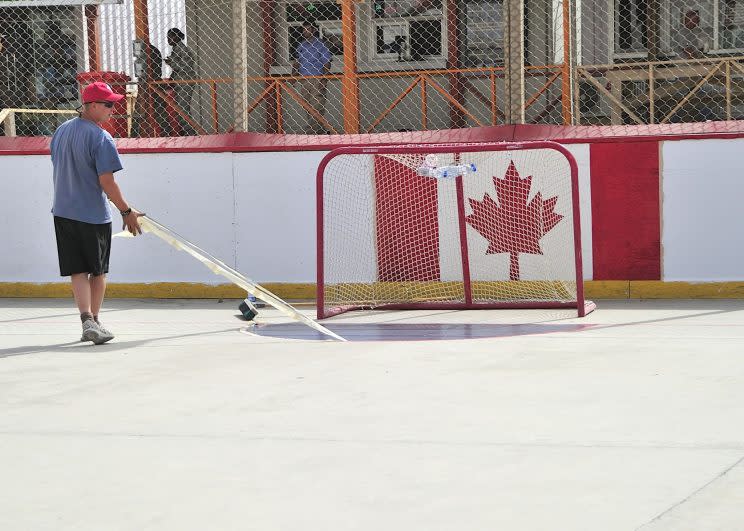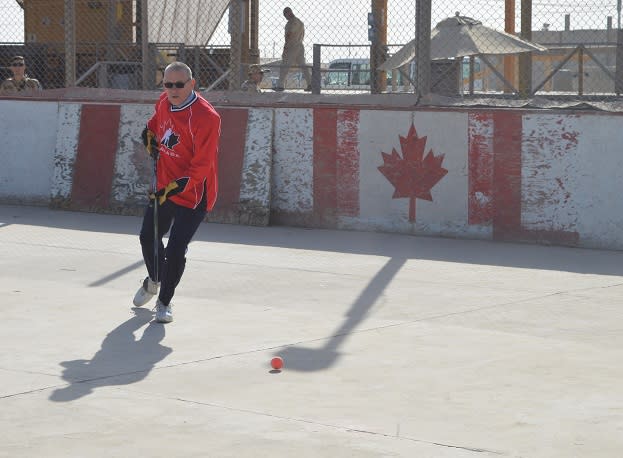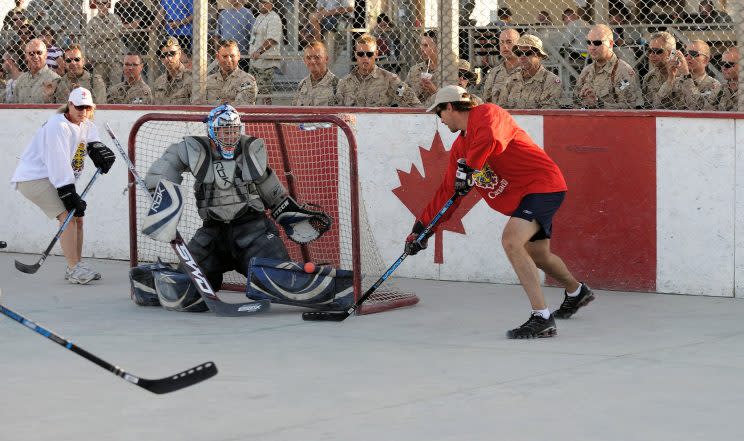Canada's Kandahar ball hockey rink is coming home

In the heart of Taliban Afghanistan, it offered a respite from the bullets and the bombs and the around-the-clock stress of war.
Before they had solid walls for living quarters or a proper cafeteria or coffee shops, the Canadian soldiers deployed to Kandahar built a little reminder of home with a ball hockey rink carved out of the desert.
More than a decade and thousands of games after the boards went up, pieces of the iconic rink are coming home.
Battle for Mosul will shape Canada’s ground commitment in Iraq
Commander-in-chief laments lack of military awareness of Canadians
Most Canadians say fallen soldiers should be honoured beyond Remembrance Day: Poll
The maple-leaf painted boards that stood behind the goalie nets at Kandahar Airfield, which served as home base for more than 40,000 Canadian soldiers, diplomats and aid workers during Canada’s war in Afghanistan, have been removed.
“For everybody who passed through, that was a focal point,” said Ken Neufeld, Canada’s ambassador to Afghanistan, whose team came up with the idea to repatriate part of the rink last fall.
“It represented a bit of normalcy in their lives. It was a link back to Canada. In that very foreign and bizarre environment in which people were living and working, here was something that felt like home,” he told Yahoo Canada News from Kabul.
Canadian troops were deployed to Afghanistan in 2001 shortly after 9/11 and served until 2014. The rink, not being a part of official military activities, was left behind when Canadian Forces packed up and moved out.
Before the boards were dismantled and replaced in late December, Neufeld and his colleagues played one last ball hockey game.
“We found a bunch of hockey sticks and we had a ball and we put on jerseys,” he said. “It was just amazing.”

The boards are now at the Canadian Embassy in Kabul. In mid-February, they will be transported back to Canada, where one set will go on display at the Canadian War Museum and the other, possibly, at the Hockey Hall of Fame.
Capt. Travis Smyth remembers fondly the nights he spent playing in the KHL — the Kandahar Hockey League — in 2010, when he was deployed to the base as the public affairs officer with the 1st Battalion Royal Canadian Regiment Battle Group out of Petawawa.
“For those of us who never played any sort of pro hockey, the joke was we were always able to say we played in the KHL,” he told Yahoo Canada News.
At that time, there were at least 20 Canadian, one American and two Slovak teams in the league on the coalition base.
After the 14- to 16-hour days that soldiers put in seven days a week, it was a welcome respite, he said. Games were played at night, when temperatures that regularly hit 40 C would drop.
“For a short time, military members were able to set aside the military mission and travel back home and play a game we grew up with. It was a little piece of Canada we had in Afghanistan,” Smyth said.
“For 30 minutes you had something you could go and do that reminded you of home.”
The rink wasn’t the only connection between Canada’s favourite sport and the soldiers.
The Stanley Cup visited the Kandahar base several times, accompanied by former NHL stars such as Guy Lafleur, Bob Probert, Mark Napier, Yvon Lambert and Tiger Williams, who faced off against the Canadian soldiers at the ball hockey rink — with predictable results.
During the 2010 Olympic Games, Canada and the U.S. faced off in Kandahar with a much better outcome for Canada.
Neufeld says the boards bearing maple leafs have been removed but the rink lives on, though not so much for ball hockey any more. It’s used primarily for dodgeball and tennis. (The base is still home to coalition forces, housing a mostly American contingent these days.)
The rink may be gone on the base, but the Canadian legacy in Kandahar continues, Neufeld said.
The birthplace of the Taliban, the province is now one of the more stable regions of the still-conflicted country, he said.
Canada’s real legacy there is in a thriving agricultural industry, thanks in large part to this country’s rehabilitation of an irrigation system, and in an education system where 35-40 per cent of students are now girls.
“Canadians can be proud of what we did and what we’re continuing to do here,” he said.




